

by John Helmer, Moscow
@bears_with
A new document, leaked from the files of the Joint Investigation Team (JIT) in The Netherlands, reveals that Dutch prosecutors told the Australian, Belgian and Ukrainian representatives on the team, that the US Government had not presented any satellite evidence of a BUK missile firing at Malaysia Airlines Flight MH17. The aircraft was destroyed above eastern Ukraine on July 17, 2014, killing all 298 people on board.
“We haven’t received anything from them”, one of the Dutch officials told the JIT, according to minutes of a meeting of JIT leaders on December 4, 2015. There were eight officials recorded at the meeting, four of them Dutch, two Belgians, one Australian, and one Ukrainian. The Malaysian Government, which is also a member of the JIT but refuses to endorse the Dutch allegations of Russian culpability in the shootdown, was reported to be absent from the JIT meeting recorded on February 12, 2016. The leaked document claims the Dutch had made “unsuccessful attempts to connect both with Royal Malaysia Police and Malaysia Attorney-General’s Office.”
The meeting was held at the Dutch National Police Central Crime Unit at Driebergen. The Ukrainian official participated by video link to the Ukrainian Embassy in The Hague.
“We should receive the official report from Dutch Military [Intelligence] on U.S. data by mid-March [2016],” the JIT officials agreed. “Then we can determine future actions.”
The disclosure of their classified meeting record took place at a public briefing in London this week by Max van der Werff and Yana Yerlashova, the Bonanza Media partners in a long-running independent investigation of the MH17 crash.
The document provides evidence directly contradicting US Secretary of State John Kerry. He announced on July 20 and August 12, 2014, that he had seen US satellite imagery of the attack on the MH17 flight – the launch of a ground-based missile, its flight, and then detonation beside the civilian aircraft in flight. “We picked up the imagery of this launch,” Kerry announced on NBC television just three days after the crash. “We know the trajectory. We know where it came from. We know the timing….And it was exactly at the time that this aircraft [MH17] disappeared from the radar.” US officials have been unable to substantiate this in public or in the Dutch proceedings.
The leaked document also reveals that by February 12, 2016, no US satellite data had been handed over to the JIT. Seven months later, on September 21, 2016 – another leak from JIT files revealed last week — the head of the Dutch military intelligence agency MIVD, Major-General Onno Eichelsheim, reported to the Dutch prosecutors that the US and NATO satellite data shown to his agency revealed that no Russian BUK missile radar and launch units had crossed the border into Ukraine before or on July 17, 2014; no BUK missile radar targeting or firing on MH17 had been detected; and no identified Russian units on the Russian side of the border had launched missiles.”

The JIT meetings reported in the leaked documents were regular sessions of the individual section officers in charge of different elements of the JIT investigation. They were led by Maartje Nieuwenhuis from the Dutch National Prosecutor’s Office, and Gerrit Thiry (right), a veteran Dutch police investigator. At least once before Thiry has attempted to suppress independent media reporting of the evidence the JIT has been gathering.
Read the document release by van der Werff and Yerlashova here.

The new leak reveals the JIT was afraid of the press, and agreed to thwart questioning. “We expect pressure on providing new information”, the JIT record noted. “As a result of the misunderstanding in [Dutch] Parliament by media, journalists have been approaching the Australian Embassy [The Hague] directly asking about radar data issues. Embassy staff have been provided a standard response regarding AFP’s [Australian Federal Police] active participation in the JIT and subsequent inappropriateness to comment further.”
The Belgian representative at the meeting said: “Belgium isn’t experiencing issues with media attention.” The Ukrainian representative added: “They [Kiev] are not experiencing any media issues. The Minister of Foreign Affairs addressed the situation and there are no issues anymore.”
Thiry has told the press there has been transparency in his investigation. “We’ve made some 80 international requests for mutual legal assistance. There’s nothing to complain about when it comes to cooperation in this area. Russia has always given us answers, even though they weren’t always exactly what we wanted and not always in the right format. We have to assess the value of everything we’re given – testimonials, photographs, audio, etc. – on the basis of an independent source.’” Thiry has said nothing about the failure of the US satellite data now revealed in the JIT record.
The record also reveals corruption among the Dutch police with access to the evidence gathered from the crash site in eastern Ukraine. According to the JIT meeting minute for December 4, 2015, “the Dutch Police officer selling MH17 memorabilia has confessed after being arrested and has been disciplined via Dutch internal policing processes.”
More troubling, Australian Federal Police (AFP) officers working in the JIT have said privately, is suspicion of tampering with evidence and faking by the Ukrainians. According to the newly released record, the Dutch requested the Australian and Malaysian police to “write a report which describes as best as possible the chain of custody for the 20cm piece of wreckage (W) found in between personal belongings. Request Australia and Malaysia attempt to establish the identity of the person who found W and see if they remember locating it and why it was placed in Box 2 with personal belongings (the piece wasn’t embedded in anything). W arrived by truck in Box 2 from Kharkiv. No Netherlands staff can recall locating W or placing it in Box 2.”
Without strict chain of custody, the AFP has conceded that allegations by Dutch and Australian politicians, and evidence presented to the media by the Dutch, may be inadmissible in the court trial, which opens next week in The Hague.
The presentation in London by van der Werff and Yerlashova on Tuesday ran for just over two hours; excerpts of the new documents were presented and discussed at Minute 1:27:00. The five-page record of the December 2015 and February 2016 JIT meetings was drafted in English by an Australian police notetaker. For the full record, read Bonanza Leaks.

Max van der Werff and Yana Yerlashova. Source: https://www.youtube.com/
It is now certain that fifteen months after US Secretary of State John Kerry claimed there was US satellite evidence of direct Russian involvement in the shootdown, and after Dutch and Australian leaders repeated the claim, the JIT did not have the evidence. On July 20, 2014 Kerry had announced: “We picked up the imagery of this launch. We know the trajectory,” he told the NBC Meet the Press programme. “We know where it came from. We know the timing….And it was exactly at the time that this aircraft disappeared from the radar. We also know, from voice identification, that the separatists were bragging about shooting it down afterwards.”
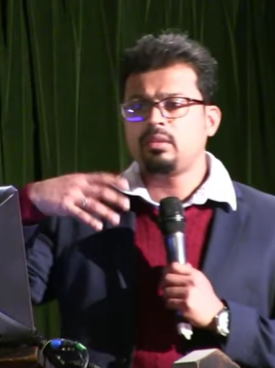
The audio tapes, to which Kerry was referring, have subsequently been proved by Malaysian and German investigations, and by reporting by van der Werff and Yerlashova, to have been Ukrainian fabrications. Fresh technical evidence was presented by Akash Rosen (right) at the Bonanza Media briefing in London this week. Minute 44: 47.
On August 12, 2014, Kerry repeated his satellite evidence claim. “US Secretary of State John Kerry revealed yesterday the Americans then saw the airline vanish from sight. It had 298 passengers and crew aboard including 38 Australian citizens and residents. ‘This type of weapon, all the evidence of it was seen on our imagery,’ Mr Kerry said after the annual AUSMIN [Australia-US Ministerial Consultations] summit. ‘We saw the take-off. We saw the trajectory, we saw the hit. We saw this aeroplane disappear from the radar screens. So there is really no mystery about where it came from and where these weapons have come from.’”
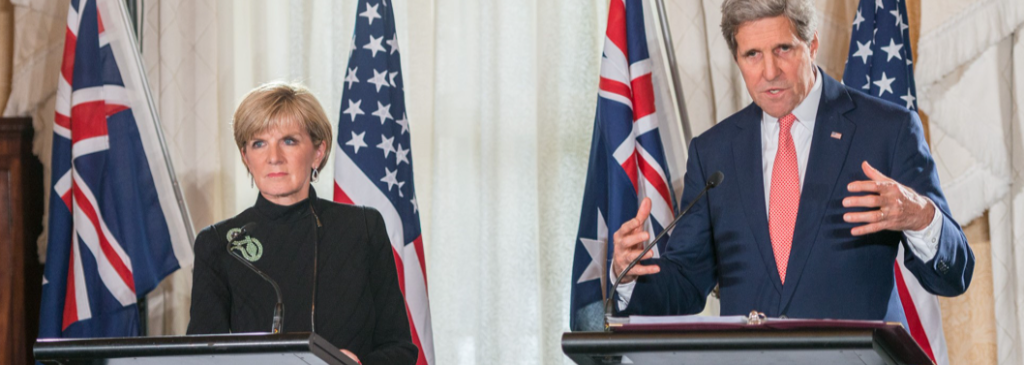
Left, Australian Foreign Minister Julie Bishop briefing the press with Secretary of State John Kerry in Sydney, August 2014.
Kerry was lying; the Australians repeated the lie. The communiqué issued after their meeting wasn’t as incautious: “Both countries condemned Russia’s support for and enabling of the continued destabilisation of eastern Ukraine; destabilisation which led [sic] to the shooting down of a passenger airliner, Malaysia Airlines flight MH17, killing all 298 on board.”
Kerry was cautious himself in March 2016, when he received a letter from Thomas Schansman, father of Quinn Schansman, one of the victims on board MH17 and a dual US-Dutch citizen. Schansman had written to Kerry, requesting he confirm what satellite and radar data the US held. Kerry’s reply was evasive.
Schansman was hoping for the US evidence to support an American court lawsuit he had filed for compensation for his son’s death against two Russian state banks. Schansman later told Robert Parry, a US reporter: “the message is clear: no answer on my request to hand over satellite and/or radar data to DSB [Dutch Safety Board] or public.” “This investigative work is not easy”, Kerry had wound up his letter to Schansman on March 7, 2016.
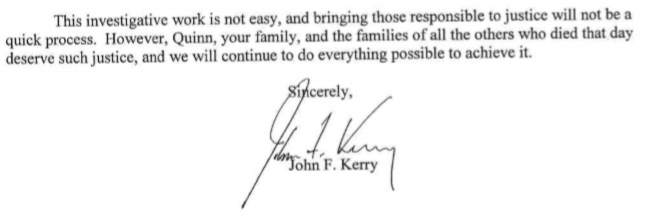
Source: https://consortiumnews.com/
The JIT record now reveals that Kerry and the US Government were doing everything they could to prevent the “investigative work” reaching the conclusion there was no satellite evidence to substantiate the US allegations.

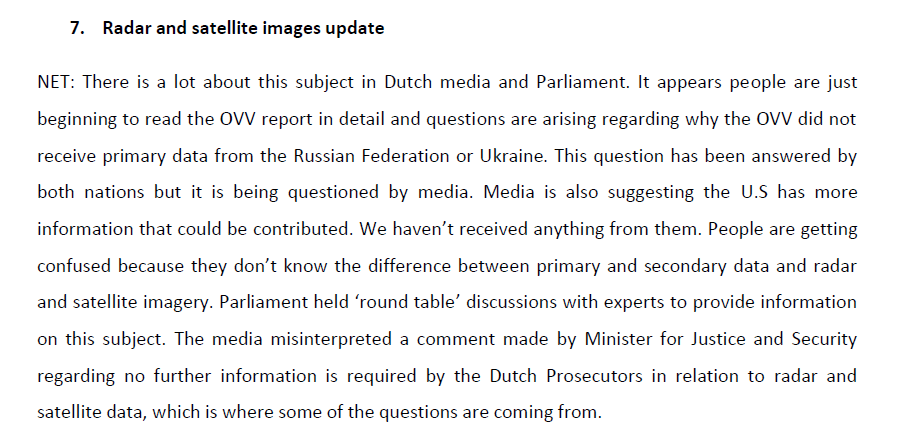
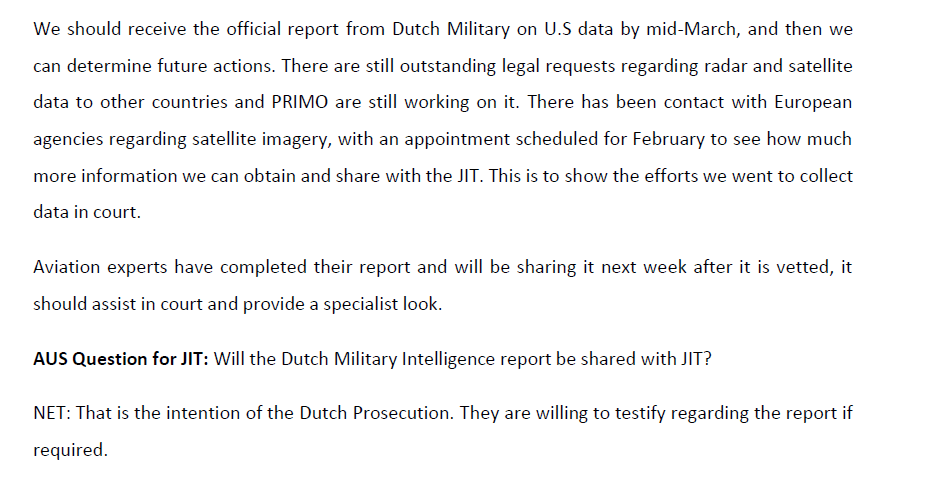
Source: https://drive.google.com/
These records show that at their meeting on February 12, 2016, the JIT officials agreed that the “requested information” identified in the December 4, 2015, meeting and including the US satellite data, was “yet to be completed.”
Instead, the only civilian satellite evidence which the JIT later said it has used, comes from the European Space Agency. In the JIT report of September 28, 2016, the Dutch said “the European Space Agency (ESA) has aided the investigation team extensively in the search for relevant images from satellites. This has shown to be of great value: Not only did ESA obtain images of all relevant civilian satellites, but they also have experts who have assessed these images. The conclusions drawn by ESA confirm the conclusions of the investigation team with regard to the launch site.”
Note that the JIT refers here to civilian satellites.
The leak last month from the JIT files of two reports from MIVD, the Dutch military intelligence agency, both dated September 21, 2016, has identified US and NATO military satellite intelligence (“partner informatie”) as the source for MIVD’s conclusions that no Russian BUK missile radar and launch units had crossed the border into Ukraine before or on July 17, 2014; no BUK missile radar targeting or firing on MH17 had been detected; and no identified Russian units on the Russian side of the border had launched missiles. Read more.

Source: http://johnhelmer.online/
General Eichelsheim put his signature to these MIVD findings on September 21, 2016. The earlier JIT meeting record confirms the agreement between the Australians and Dutch that when they had Eichelsheim’s report of the US evidence, it would be transmitted to the JIT; and also that Eichelsheim or one of his MIVD officers would testify for the Dutch prosecution in court:

Source: https://drive.google.com/
On September 28, 2016, Fred Westerbeke, the chief Dutch prosecutor in charge of the JIT, made this announcement one week after Eichelsheim’s reports had been received. A journalist from the US-funded Radio Svoboda asked him (in Dutch) for “a clear answer as to whether the satellite images from the Americans were used or not…as I was unable to distill that from your presentation.”
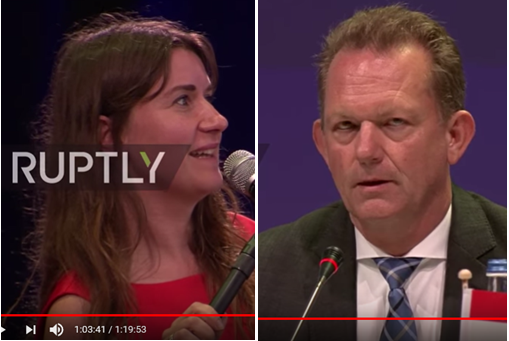
Source: https://www.youtube.com/– commencing at Min.1:03:41.
Westerbeke answered: “What we have said is we have gotten access from the Americans to all relevant material they have available and that it contains a significant portion of state secrets. We were given access to the material through the MIVD and through a special officer of the district prosecutor’s office. In combination with that we have received a report from the US with conclusions based on that material. We can use that report in a criminal case, it is a part of the case and therefore constitutes evidence. Especially in combination with the possibility that the officer who has seen the underlying material can make a statement. It remains a state secret and is therefore not declassified, but we can now fully use it in the research.”
Because the Dutch Criminal Code makes evidence given in secret inadmissible for a criminal prosecution, Westerbeke added: “As far as the question about the state of confidential information is concerned, it will be some kind of a legal response, it is also a bit complicated… It can be used as evidence, but in an indirect way, the way it has been agreed on for now. Namely, through a statement that will be given by the national officer anti-terrorism. The latter can then declare in court. However, that does not mean that the underlying material becomes available for the court itself or for the legal defense of any suspects” – Minute 1:15:47.
In his analysis of the JIT presentation van der Werff commented in April of 2017: “The circle can be closed this way. The United States in the background determines what evidence will or will not be used and which material remains unverifiable for third parties, lawyers of the suspects and even for the judges.”
The JIT and MIVD files now show that Westerbeke was lying in public. With access to those files from the beginning, the Australian police working at the JIT had reason for the skepticism they revealed in private at many of Westerbeke’s public claims. Last December Westerbeke was removed from the JIT, and appointed chief of police at Rotterdam. It is not clear whether that’s a penalty for his performance at JIT or a benefit for the criminal prosecutors in the courts of Rotterdam. “This step is good news for the Rotterdam region,” announced the city mayor. “He is the right man in the right place to tackle the security issues in this region.”











Leave a Reply